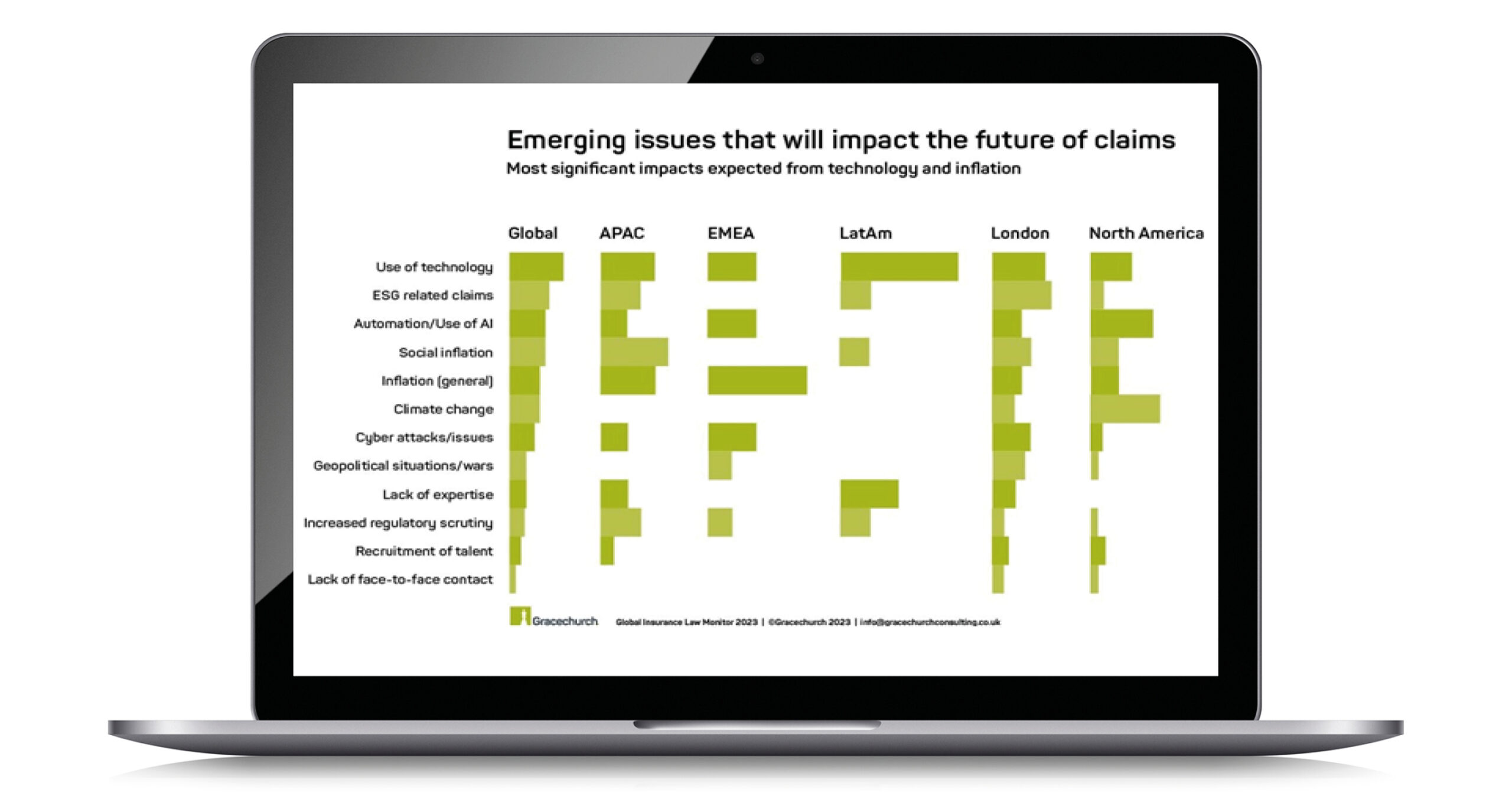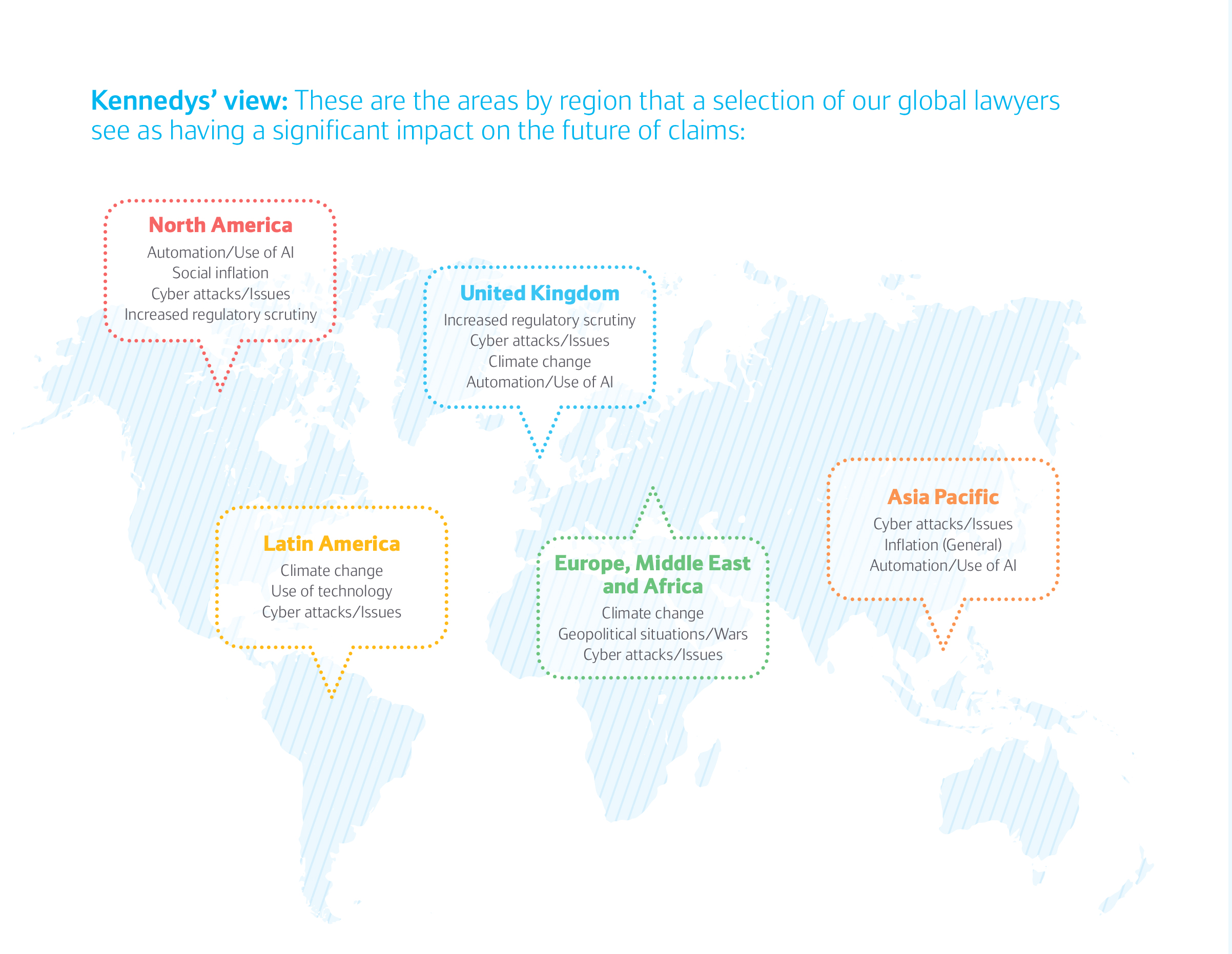Artificial Intelligence: exploring risks and rewards |
Contact: Karim Derrick
This thought leadership article was first published by Insurtech Insights
Karim Derrick of Kennedys IQ explores the risks and rewards as the sector looks to an AI future.
Alongside environmental, social and governance (ESG), geopolitics and claims inflation; developing technologies and artificial intelligence (AI) in particular, are top of the risk agenda for the insurance sector. Failure of AI, the malicious use of AI by third parties, and issues with data are all key concerns.
While there is considerable risk associated with AI, there are also significant opportunities, with huge potential when it comes to risk assessment and the management of claims.
Insurers are operating in an increasingly unpredictable environment. Geopolitics, ESG and disruptive technology are amongst the pivotal issues for the sector.
An recent report by law firm, Kennedys – Global forecast 2024: Evolving insurance risks – found that developing technologies and AI in particular is one of the insurance industry’s top concerns in 2024 and is expected to have a significant impact on the insurance market in the year ahead.
An AI generated deepfake image offered as evidence in support of a fraudulent claim is just one of the new technology related risks they face.
1. Future of claims: what are the emerging issues?
The report examines research by Gracechurch Consulting that surveyed 325 insurance claims professionals in London, North America, Asia Pacific, Europe and Latin America.
Although there was variation by region, the role technology will play in claims management is clearly one of the top items on the business agenda across the globe.

Figure 1 – Global Insurance Law Monitor: Gracechurch interviewed 325 claims professionals in London, North America, APAC, Europe and LatAm through 2023
Kennedys put the same question to its partners working across the firm’s international offices and the use of technology and AI was once again one of the top responses given; alongside ESG risks and inflationary drivers.
Drilling down further, there was some variation based on geographies. In North America, automation and the use of AI was the main emerging issue likely to impact on claims, while in Asia Pacific and EMEA it was cyber-attacks that topped the list.

Figure 2 – Kennedys’ Global forecast 2024: Evolving insurance risks
2. AI risks
Generative AI may be in its early stages of development, but the technology is only going to become more effective. The application of language models across different sectors is already bringing new benefits and opportunities, which will continue to evolve at pace.
Autonomous vehicles and healthtech provide examples of how this technology is already being applied in a game changing way.
In broad terms, AI risks falls into three categories: failure of the AI – both human failure and technology failure, malicious use of AI by third parties, and issues with data.
When AI performs in an unexpected way, this could lead to claims for:
- Property damage: malfunctioning warehouse robots can cause fires and other damage.
- Personal injury / bodily harm: self-driving cars can cause accidents in scenarios on which they have not been trained.
- Reputational damage: customer service chatbots may inadvertently damage a company’s reputation.
- Medical malpractice: misdiagnosis in medical screening as a result of a malfunctioning can lead to catastrophic results.
- Fraud: AI generated deepfake digital content is offered as evidence in support of a fraudulent claim.
- Discrimination in hiring: unintentional bias in selecting applicants for employment.
A particular challenge of evolving AI capabilities is the potential for AI failures that do not neatly fit into existing insurance lines. For example, while cyber insurance typically covers data leakage, it will not typically cover bodily harm, brand damage or damage to physical property, which could occur from the same event.
Mitigating these risks and achieving the global benefits of AI will present unique governance challenges and will require global cooperation and representation.
3. Innovative solutions: minimising risk
So, we know what some of the AI claims risks are – but what about the considerable opportunities for insurers?
By using AI, insurers can speed up the claims journey. Customer service chatbots are a visible example of helping to filter simple customer queries. AI can also help spot suspicious behaviour and otherwise improve legacy infrastructure to improve process management. AI is also exerting its influence on insurance pricing models. Dynamic pricing strategy powered by AI is already creating cheaper policies for low-risk customers.
The use of data means that insured risks become more predictable. As a result they can also become more preventable, thereby minimising losses. Embracing technological solutions can allow risk measurement tools to be improved, benefiting both insurers and corporates.
Reputation risk is considered an intangible asset that is rising in importance when it comes to company value. According to a joint Lloyd’s of London/KPMG report, the importance of intangible assets has grown to more than 85% of asset value, with reputation and brand identified as the most important.
If triggered, risks to reputation can result in huge financial losses – consider those suffered by Facebook in 2018 when its stock plummeted following a massive data breach and privacy scandal.
Data from financial services provider insurer, Allianz, suggests that businesses that fail to properly prepare for events that may damage their reputation could see their value slashed by as much as 30%.
To mitigate reputational harm, a tool is being developed which, by analysing content – from corporate documents to publicly available information – can create a real-time reputational risk index. This comprises any risk relating to an organisation’s corporate citizenship via ESG practices that impact on a company’s bottom line.
4. Large language models: paving the way to a bright future
Large language models (LLMs) are rapidly becoming one of the most talked about technological innovations in the internet age.
Examples like the above tool are just the beginning. Developments in large language models are providing some compelling use cases for business – from translation to transcription, to market research, malware analysis and customer support. The interpretive and generative power of LLMs also means that data science results can now be achieved much faster than a year ago.
LLM tools used in an insurance and / or legal context are typically based on generic language models such as OpenAI’s GPT. Even though such solutions are utilising such general ‘out-of-the-box’ capability, the impact is significant. These models have been trained on eye watering amounts of foundational data and have been shown to be capable of an incredible range of general tasks.
The fact that LLMs are able to do as much as they already can, in what is a very specialist area, is incredible. Recognising that we are seeing newer, more powerful versions of these models being released almost every week means the potential application is profound.
The future will see insurers taking these refined models and harnessing them for specific domains, fine tuning them to work specifically on insurance policies.
Advances in AI are also likely to impact insurance workers. Indeed, a UK government report published in November 2023 found that those working in the finance and insurance sectors are among those most exposed to workplace changes ushered in by AI. The corollary is that firms will need to adapt to ensure those in their workforce have the skills they need to make the most of the potential benefits.
One area of potential is improving and even transforming the claims process. In the not too distant future we should expect to go from developing tools that are as good as human performance, to those that exceed it.
Leading expert on the future of legal services, Professor Richard Susskind OBE KC (Hon), talks about how we are fast approaching a world where machines are better able to diagnose a tumour than a human, and that those presenting symptoms will likely soon demand that they are seen by machine rather than a medical professional, creating liability not because of AI’s use, but because it has not been used.
However, there are obstacles to overcome first, including the risk of hallucination. Steps will therefore be necessary to avoid LLMs being misled by information. Nevertheless, the potential is very promising.
The insurance industry is at a pivotal moment. It is time for organisations to calculate AI risks and develop existing practices or create new ones to responsibly and ethically deploy developing technologies and use data, as well as being prepared for evolving regulation. Responsible AI is the only approach to mitigate AI risks.
Specifically, AI developments are an opportunity to re-shape and transform claims handling and underwriting processes, building on top of the power and potential of machine intelligence. The shape this evolution takes will be decided by individual insurance businesses. The industry will need to continue to think about re-aligning their strategic priorities to create and adopt the innovative solutions needed, today and in the future.
Related news and insights
Assessing the impact of the 17th Edition of the JCG on OIC Claims
The highly anticipated 17th Edition of the Judicial College Guidelines (JCG) has begun to reach recipients. Let’s delve into the standout updates from this edition and examine their potential implications for Official Injury Claim (OIC) claims.
Kennedys IQ on using AI for ‘highly complex’ claims
Karim Derrick, chief products officer at Kennedys IQ, shares how the company is using artificial intelligence for complex claims documents.
Kennedys becomes first law firm to join prestigious US fintech research group
Kennedys IQ, through our global law firm Kennedys, has joined the prestigious US-based Center for Research toward Advancing Financial Technologies (CRAFT) as it cements its position as one of the world’s most innovative law firms.

Kennedys IQ on using AI for ‘highly complex’ claims
Karim Derrick, chief products officer at Kennedys IQ, shares how the company is using artificial intelligence for complex claims documents.

Kennedys becomes first law firm to join prestigious US fintech research group
Kennedys IQ, through our global law firm Kennedys, has joined the prestigious US-based Center for Research toward Advancing Financial Technologies (CRAFT) as it cements its position as one of the world’s most innovative law firms.

Bright minds, brighter horizons: Kerala’s young innovators
Kennedys IQ’s Future Innovators programme saw students from a tribal school in Kerala develop innovative ideas for solving both local and global problems. In March, Kennedys concluded Innovation Month by inviting young students to share their ideas.


